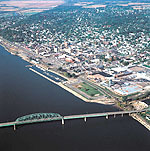Muscatine
Our Information
About Our Town
History of Muscatine
The town that is now known as Muscatine began its existence in the summer of 1833 when Colonel George Davenport of Rock Island, Illinois, set up a trading post in part of the unexplored territory along the Mississippi River.
James W. Casey staked a claim near the present Broadway Street and the river in 1835, and began cutting timber to sell as fuel for the steamboats that stopped.
For the next two years, this area, which included Colonel Davenport's trading post, was called Casey's Woodpile or Casey's Landing.
In 1836, Colonel Vantater purchased Colonel Davenport’s trading post and with this purchase, Colonel Vantater began to create the plans for a town. He named the town after his hometown of Bloomington, Indiana, and in 1837, Bloomington was made the county seat.
Over the years, it became increasingly difficult to receive mail in Bloomington. It was often sent to Bloomington, Illinois or Bloomington, Indiana and sometimes Burlington, Iowa. In 1850, the new name of Muscatine was adopted for both the town and the country. The name Muscatine is unique – even today, there is no other city in the United States or the World with the same name.
The exact origins of the name Muscatine are unknown. Some historians believe it was taken from the Mascoutin Indians who lived in the area during the 18th century. Others believe it came from the Indian name for what is now known as Muscatine Island. It is known though, that “Muscatine” means “Fiery Nation”.
Early industry in Muscatine centered around lumbering, saw mills, sash and door factories, and other forms of woodworking. In 1887, John Fred Boepple immigrated to Muscatine from Germany. By accident, Boepple found that the mussel shells that collected in the turn of the Mississippi River closely resembled the fashionable buttons made of expensive import marine shells. Muscatine soon became the world’s largest pearl button manufacturer with its factories employing over half of the Muscatine workforce at the turn of the century. In 1905, over 1.5 billion pearl buttons were made in Muscatine. Today, Muscatine remains the “Pearl Button Capital of the World.”
In 1892 HJ Heinz decided to locate one of their principal canning plants in Muscatine – the company’s first expansion outside of the corporate headquarter location of Pittsburgh, Pennsylvania. Numerous additions have been made to this plant making it now the largest Heinz plant outside of Pittsburgh, and the largest canning plant between the Mississippi River and the Rocky Mountains. Muscatine is also home to the world headquarters of two Fortune 500 companies that began in Muscatine as small businesses: Bandag, Inc and HON Industries.
Mark Twain who lived in Muscatine in 1854 once wrote “I remember Muscatine for its summer sunsets. I have never seen any on either side of the ocean that equaled them.” The town’s noted sunsets combined with rolling terrain, thriving business community, quiet neighborhoods, and strong family values gives Muscatine a unique personality all its own.

